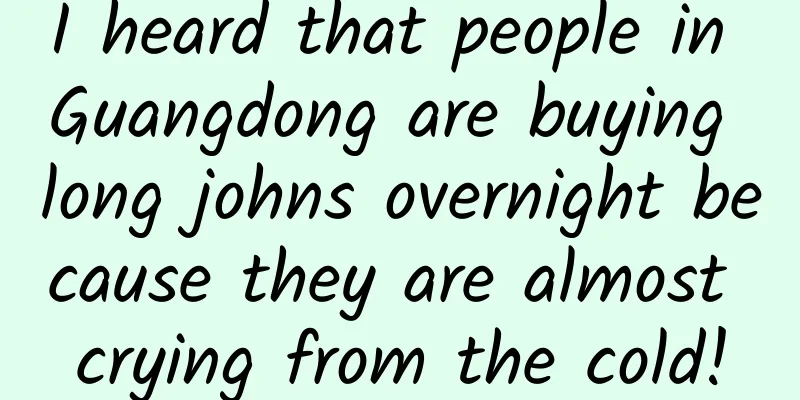I heard that people in Guangdong are buying long johns overnight because they are almost crying from the cold!

|
Key Points ★ The perceived temperature is actually affected by many factors such as humidity and wind speed. ★ Architectural design in the south rarely takes warmth into consideration, and the humidity in the south is high, so the perceived temperature is naturally very low. ★ If you want to keep warm, air conditioners and heaters are two powerful tools. In addition, you can also seal the gaps in doors and windows to prevent heat loss. In the past few days, a cold wave has moved southward and hit Guangdong! Southern netizens who were caught off guard complained: "Coldness makes people younger. The security guard downstairs who is over 60 years old is frozen like a grandson." It has to be said that this wave of cold currents is really strong. They swept across the entire Chinese territory from north to south, pushing the 0-degree isotherm to northern Guangdong, and the highest temperatures in Guangzhou and Shenzhen, located in the subtropical zone, also dropped to single digits. Friends in Guangzhou who just claimed that "it's still slippers and short sleeves this afternoon" are now calling for "putting on long johns together." The temperature drop and rainfall mean it is not just cold. | Tuchong Creative The meteorological department said that the local temperature will drop sharply from the 26th to the 27th, accompanied by strong winds and rain, and it will feel very cold, so please remember to add clothes and quilts. Until the 29th, the temperature will still remain low and will not rise significantly until after the 30th. The weather department's warning mentioned "feeling cold", which means that the temperature we feel is actually very different from the actual temperature. So, what causes this difference? 01 Feeling cold is not just because of the cold weather Although the perceived temperature itself is not very profound, there are too many factors that affect it, such as different locations, seasons, venue size, shape, ventilation conditions, wall thickness, external sunlight conditions, etc., as well as different personal physical fitness, so the perceived temperature will vary significantly. However, the academic community has still invented a series of semi-quantitative methods to describe the perceived temperature. In the higher temperature range (>10°C), we can correct the air temperature by combining wind speed and humidity to calculate the perceived temperature. The formula for calculating the perceived temperature is shown in the figure: Don't understand? Don't worry, we'll answer your questions right away. | Graphics by the editor The higher the wind speed, the more heat the wind can take away from the body surface, and the perceived temperature will be significantly reduced. When the humidity increases, the evaporation of water on the skin surface is inhibited, and the perceived temperature will increase accordingly. Therefore, even if the temperature is the same, the high humidity in the south in summer will obviously make people feel hotter than in the north. The so-called "sauna day" can be explained by the effect of humidity on the perceived temperature. "Sauna days" are also when the lotus leaves are green. | Tuchong Creative However, careful readers may realize that the humidity in the south is not small in winter, so why does the human body feel colder instead of hotter? In fact, the effect of humidity on perceived temperature is very complex, and the above conclusion is limited to higher temperatures (>10℃). In winter, when the temperature is low, the human body temperature is higher than the ambient temperature, and the body will dissipate heat. Since water can transfer heat better than air, the heat in the human body is continuously transferred out through the "water" mixed in the clothes. Therefore, the higher the relative humidity (more water vapor) in winter, the more heat is dissipated, and the colder it feels, which is called damp cold. To put it bluntly, high humidity makes people feel hotter in the summer and colder in the winter. 02 Too bad, houses in the south don't take insulation into consideration In addition to humidity, the perceived temperature in the room is also related to the radiant heat from the wall. In summer, when the outdoor temperature is high, the wall temperature rises due to the heat, and the heat is transferred into the room by radiation, so the perceived temperature may rise relative to the actual temperature. In winter, when the outdoor temperature is low, the wall temperature drops due to the cooling, so the perceived temperature may drop relative to the actual temperature. However, it is difficult to accurately quantify the thermal insulation of a house. According to experience, in a closed room, the air temperature, humidity and wall radiant heat affect the perceived temperature by approximately 40%, 20% and 40% respectively, so the role of radiant heat cannot be ignored. However, in winter, the main factor affecting the perceived temperature is actually air tightness. Once a large number of gaps are created between indoors and outdoors where air can flow freely, not only will a cold wind be formed, but it will also promote heat convection between indoor and outdoor air, thereby accelerating heat loss. In such a room with ventilation everywhere, the perceived temperature will obviously be lower than the actual air temperature. Guangzhou's architectural designs rarely consider keeping warm in winter. | Tuchong Creative Buildings in southern my country, especially in subtropical areas such as Guangdong, are built with little consideration for winter warmth, so they are exposed to the cold wave with insufficient insulation and poor air tightness. In addition, single-layer glass is commonly used in southern China. Once the outside temperature drops sharply, the glass will be cooled first, causing the heat in the room to dissipate to the outside in the form of radiation. Not to mention the relative humidity of 80% or 90% in the south in winter, so the perceived temperature can easily be significantly lower than the actual temperature. 03 How to deal with the cold wave in the south? In Guangdong, it is obviously not something that can be done in a few words, such as central heating, thickening walls, using double-glazed windows, and laying thermal insulation tiles, just like in the north. So, friends in the south, what methods can you use to survive the current unbearable cold wave? First of all, air conditioning is of course one of the ultimate weapons to fight the cold in the south. Air conditioning can raise the temperature through heat convection, and it also has a dehumidification effect. Staying in an air-conditioned room will naturally make your body feel warm. The air conditioner doesn't have a heating function? Try a heater. | Tuchong Creative However, many air conditioners in Guangdong may not have heating function at all. In this case, it is very necessary to prepare a small heater. The current various "little suns" have high power utilization efficiency and directional effect by adding reflective covers, etc., and they are all very good to use. But don't forget to pay attention to safety when using electric heaters. Secondly, if necessary, you can put sealing strips on the door gaps to prevent the air conditioning from escaping in the summer and to prevent the cold air from entering in the winter. Do not underestimate the gaps connecting the inside and outside of the house. Windows are the most serious link for heat loss. At night, when people are in the house, they should close the curtains in time. Curtains can not only block the cold air entering through the window gaps, but also prevent the hot air blown out by the air conditioner from being cooled by the glass. In short, we can protect ourselves by adding more clothes, or we can make good use of modern gadgets such as air conditioners and heaters. By hiding behind layers of warming measures, we won't have to worry about cold waves. Author | Li Rui, PhD in Physics, Osaka University Review | Ai Wanxiu, Chief Expert Researcher, Climate Service Office, National Climate Center Editor | Jiang Fan Editor | Ding Zong This article is produced by the "Science Rumor Refutation Platform" (ID: Science_Facts). Please indicate the source when reprinting. The pictures in this article are from the copyright gallery and are not authorized for reproduction. |
>>: In winter, besides dirt, there is also this...
Recommend
Entry-level high-defense server rental costs, low-cost high-defense servers
The high-defense server is used to defend the web...
Flowers no longer have to take the blame, as they are actually the culprit for spring pollen allergies!
Sneezing, stuffy nose, rash... Do you have these ...
The "Ice Dragon" is roaring! The first cold wave of the New Year is coming, and the temperature will drop by more than 18℃ in some places!
Recently, most parts of China have been sunny to ...
Let’s be honest: if you slack off while working, you will be more tired!
Have you ever had such an experience of "sla...
Android 5.1 quietly upgraded to version LMY47E
As usual, after each major Android version is rel...
60 super practical new media operation and marketing tools!
As a new media operator , you need to be able to ...
If creativity is not enough, then malicious intent can be used to make up for it. Because the prospects for iPhone 7 are worrying, what tricks has Apple invented?
Since the death of Steve Jobs, the voices critici...
E-commerce 618 | How to design posters for information flow promotion ads?
With the hot Internet e-commerce launching variou...
Guangdiantong backend operation guide!
Recently, many newbies have turned to information...
After reading this article, you can also pick up meteorites in the wild!
Although I have been doing meteorite research, Bu...
Sony's new flagship Z4 is released: These points are disappointing
Sony has finally officially released its new gene...
Qian Sanqiang: Founder of China's Atomic Energy Science | Childhood of the Hero of "Two Bombs and One Satellite"
Qian Sanqiang, a nuclear physicist, is the founde...
Staying up late to watch the game, how to take a nap? Huaxi doctors: Don't exceed this time, otherwise...
Let Dr. Huaxi take a look Which babies are there ...
HTML5 gesture detection principle and implementation
Preface With the richness of hybrid applications,...
The little red fruit "stained with snake saliva" is neither poisonous nor a fruit
As a botanist, the questions I answer most often ...









